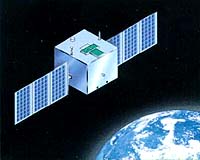 The China Xi'an Satellite Monitoring Center announced in Xi'an June 24 that six historic leaps had been successfully realized in China's space monitoring technology, the six leaps are: "flying to the outer space, returning to the ground, synchronous positioning, one net governing several satellites, international compatibility, and the recovery of spaceship".
The China Xi'an Satellite Monitoring Center announced in Xi'an June 24 that six historic leaps had been successfully realized in China's space monitoring technology, the six leaps are: "flying to the outer space, returning to the ground, synchronous positioning, one net governing several satellites, international compatibility, and the recovery of spaceship".
In 1970, China launched the first man-made earth satellite, the "Dongfanghong 1", the initially set up monitoring network of the Xi'an Satellite Monitoring Center had successfully provided the satellite with monitoring support, thus making China the world's fifth country that can independently launch satellites.
In 1975, under the accurate tracing, surveying and control of the Xi'an Satellite Monitoring Center, China succeeded in recovering the first retrievable satellite it launched for the first time, and China thus became the world's third country that can master satellite recovering technology.
In 1984, China launched the earth-synchronous communication satellite, the "Dongfanghong 2", for the first time, the Xi'an Satellite Monitoring Center successfully conducted a series of space actions toward the satellite, and accurately positioned the satellite in the 36,000-km equatorial space in one week, breaking the foreign record of positioning the satellite within 23 days, China thus became one of the few countries that can master the technology of orbit transfer and synchronous positioning and put an end to the history of China's long-term lease of foreign communication satellites.
Since the 1990s, China's aerospace launching has entered the international market. With its first-rate technology and super-quality service, the Xi'an Satellite Monitoring Center contracted for China to provide reliable and accurate monitoring support for the launch of over 10 satellites including Asia-1 and 2, Australia B1 and B2 communication satellites as well as the China-Pakistan resource satellite, the US iridium satellite, and thus earning it a good international reputation.
China's satellite precision orbit determination technology has developed from the original orbit determination precision of one km to the present meter-level range, squeezing itself into the advanced world monitoring ranks. The Xi'an Satellite Monitoring Center has also created a satellite control mode whereby "one network governs several satellites", a model with Chinese characteristics, with the result that each satellite can be used exceeding its designed service life and can yield maximum efficiency.
In China's previous three launches of the "Shenzhou" experimental spaceships, the Xi'an Satellite Monitoring Center splendidly fulfilled the tasks of monitoring the spaceships. The center has rich experiences in monitoring emergency and satellite recovering processing, its "rescue" of the "Fengyun-1" satellite was praised as a miracle in the world aerospace history, its forecasting of the fall of the US "sky laboratory" satellite, the former Soviet nuclear power reconnaissance satellite as well as the "peace" space station was highly praised by the international airspace circle.
The Xi'an Satellite Monitoring Center has formed a space monitoring network with fixed monitoring station and action station as the key components, it possesses the ability to provide monitoring support and service for domestic and foreign satellites of different orbits-high, middle and low, frequency ranges and categories. It is reported that the center has so far completed the monitoring tasks for China's launch of over 70 domestic and foreign satellites, spaceships as well as strategic rockets, with its success rate reaching 100 percent.
A responsible member from the Xi'an Satellite Monitoring Center indicated that the center would constantly impact the frontier of the international monitoring technology, expand international exchange and cooperation, build the center into a new generation of space monitoring city reaching international competitive standards, and create outer-space brilliance for the Chinese.
( June 27, 2002)
|

